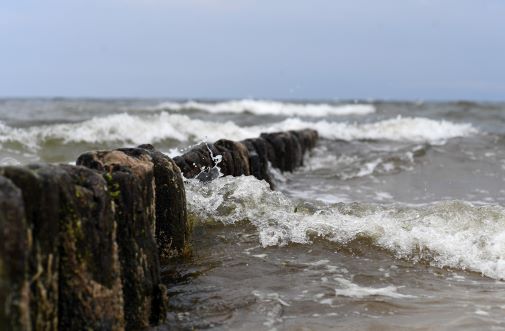More hybrid and nature-based solutions are urgently needed to protect coastal communities from climate change
Posted on 24 April 2024
 Researchers found nature-based solutions can help protect, support and enrich coastal communities
Researchers found nature-based solutions can help protect, support and enrich coastal communities
University of York academics working with academics from The University of Tokyo found that common “hard” coastal defences, like concrete sea walls, might struggle to keep up with increasing climate risks.
Policy implications
The researchers found that combining them with nature-based solutions could, in some contexts, create defences which are better able to adapt to climate risks. The work has international implications for policymakers, coastal planners and communities looking to make evidence-based decisions.
Researchers reviewed 304 academic articles on the performance of coastal defences around the world, including: natural environments; soft measures (which support or enrich nature); hard measures (such as concrete sea walls); and hybrid measures.
Enriching communities
Soft and hybrid measures turned out to be more cost-effective than hard measures, and hybrid measures provided the highest reduction in potential hazards. Academics in both York and Tokyo believe this careful inclusion of nature-based solutions can help protect, support and enrich coastal communities.
The findings were published in the journal of Nature Communications earlier this month.
Urgent research
Professor Lindsay Stringer, Director of the York Environmental Sustainability Institute, said: “In parts of the UK where coastal defences are needed, different kinds of benefits can be harnessed according to the types of defences employed and that this variation in potential benefits needs greater consideration in the planning of coastal protection efforts.”
Professor Stringer said that understanding the best approaches for creating lasting coastal defences was both vital and urgent with the research shining a light on the benefits of a hybrid approach for the first time.
Carbon savings
Professor Stringer added: “Particularly in lower risk areas there's a strong case for making sure we consider nature based components within our approaches to coastal defence and that we should ensure carbon emissions are taken into account, or in the case of nature-based and natural measures, the carbon savings, when designing the measures.”
The research found that soft, hybrid and hard measures performed much better than unvegetated natural systems in terms of reducing risk and mitigating climate change but that their performance varies in terms of magnitude and direction.
Substantial variation
Professor Stringer added: “Compared to unvegetated tidal flats, soft hybrid and hard measures are much better at attenuating wave energy and height, reducing coastal erosion and flooding, accumulating sediment and stabilising shorelines. However, the performance of all measures declines in high energy and high risk conditions. Hard and hybrid measures containing grey infrastructure components performed slightly better for wave attenuation and shoreline maintenance than soft and natural measures, but there is substantial variation in risk reduction outcomes for hard measures. There's no one size fits all solution.”
To better understand the performance and benefits of different hard and nature-based coastal defenses, an international team compared the results of 304 academic studies. Nature-based coastal defenses included: “natural” ecosystems, for example, existing mangroves and coral reefs; “soft” measures, which restore, rehabilitate, reforest or nourish natural ecosystems; and “hybrid” measures that combine both nature-based components and hard structures, such as placing concrete breakwaters in front of mangroves.
Greening coastlines
There are many benefits to the hybrid approach. “Greening coastlines can create spaces which enhance quality of life, foster community well-being and inspire environmental stewardship too. But new approaches need caution too”.
Lam Thi Mai Huynh, a doctoral student in sustainability science at the University of Tokyo and lead author of the study, said: “Sea walls, dikes, dams and breakwaters, the so-called traditional hard measures, despite being the most popular coastal defenses globally and with proven track records, are facing challenges to keep pace with increasing climate risks.
Reducing risk
“These hard structures are expensive to build and require continuous upgrades and repairs as sea level rises and climatic hazards become stronger. Although they are good at mitigating certain coastal disaster risks, they can also cause significant disruption to coastal communities and have adverse environmental effects. Furthermore, they often significantly alter the seascape and sometimes alienate local communities from nature and the very environment we seek to protect.”
Professor Alexandros Gasparatos from the Institute for Future Initiatives at the University of Tokyo said: “By incorporating such natural components, we can create coastal defences that reduce risk and also offer substantial environmental benefits. We believe that such strategies are very promising in many parts of the world, but they are also not a ‘fix-all’ solution.
“Until there are many more such experiments focusing on this, we must caution against any universal assumptions about the comparative performance of coastal defense options, whether natural, soft or hybrid measures.”
Explore more news

York to co-lead £2.5m project to explore impact of justice system reform and funding cuts
Wednesday 1 May 2024

Report calls for urgent action to boost children’s mental health support through schools
Friday 26 April 2024

Climate change set to take over as key driver of biodiversity loss by 2050, experts warn
Thursday 25 April 2024

Conservation actions are effective at halting and reversing biodiversity loss, study reveals
Thursday 25 April 2024

More than a quarter of people with Covid infection develop Long Covid, new research reveals
Thursday 25 April 2024
Media enquiries
About this research
Lam T.M. Huynh, Jie Su, Quanli Wang, Lindsay C. Stringer, Adam D. Switzer, Alexandros Gasparatos. Meta-analysis shows hybrid engineering-natural coastal defences perform best for climate adaptation and mitigation. Nature Communications. April 9th 2024. DOI: 10.1038/s41467-024-46970-w
L.H acknowledges the support of Grant-in-Aid Research Fellowship for young Scientist offered by the Japan Society for the Promotion of Science (23KJ0544). A.G is supported by a Grant-in-Aid for Scientific Research A offered by the Japan Society for the Promotion of Science (22H00567). A.D.S. is supported by the Singapore Ministry of Education Academic Research Fund (MOE2019-T3-1-004 and MOET32022-0006).
